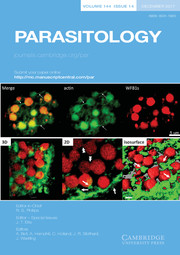Identification of a novel PYP-1 gene inSarcoptes scabieiand its potential
as a serodiagnostic candidate by indirect-ELISA
Jing Xu, Xing Huang, Manli He, Yongjun Ren, Nengxing Shen, Chunyan Li,Ran He,
Yue Xie, Xiaobin Gu, Bo Jing, Xuerong Peng and Guangyou Yang

Abstract
Scabies is a parasitic disease caused by the ectoparasiteSarcoptes scabiei, affecting different mammalian species, including rabbits, worldwide. In the present study, we cloned and expressed a novel inorganic pyrophosphatase, Ssc-PYP-1, fromS. scabieivar.cuniculi. Immunofluorescence staining showed that native Ssc-PYP-1 was localized in the tegument around the mouthparts and the entire legs, as well as in the cuticle of the mites. Interestingly, obvious staining was also observed on the fecal pellets of mites and in the integument of the mites. Based on its good immunoreactivity, an indirect enzyme-linked immunosorbent assay (ELISA) using recombinant Ssc-PYP-1 (rSsc-PYP-1) as the capture antigen was developed to diagnose sarcoptic mange in naturally infected rabbits; the assay had a sensitivity of 92.0% and specificity of 93.6%. Finally, using the rSsc-PYP-1-ELISA, the Ssc-PYP-1 antibody from 10 experimentally infected rabbits could be detected from 1 week post-infection. This is the first report ofS. scabie inorganic pyrophosphatase and the protein could serve as a potential serodiagnostic candidate for sarcoptic mange in rabbits.
copyright:© Cambridge University Press 2017.
Parasitology,(2017). doi:10.1017/S0031182017001780
Read Full Text:https://doi.org/10.1017/S0031182017001780